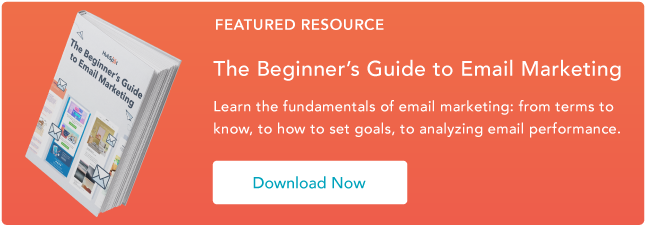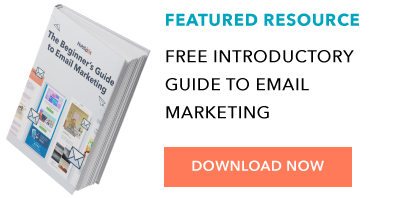In 2017, there were 3.7 billion email users across the globe. That number is expected to reach 4.3 billion by 2022.
With half of the world’s population on email, and the ability to reach people at any time of day, email marketing remains a crucial technique to build a customer base.
So how do you attract people to your email list? There are a few important steps, but it all starts with an email sign up web form.
What Is An Email Sign Up Form?
An email sign up form is used to collect email addresses from leads and potential customers. These forms are are embedded on a webpage where a visitor can enter their email address in a form field to be added to your email newsletter.
A lead might provide their email address for any number of reasons — to receive details about sales, blog post notifications, a discount code or information about your business. Either way, that makes your email sign up form one of the most important things on your site. And while they’re simple to create with the help of a form builder, you’ll still need to put some time and thought into how you build, format and embed your form.
Let’s go over some ways to create a sign up form that will get more leads on your email list.
5 Email Sign Up Form Best Practices
Whether you’re looking to reach ten people or ten million, you’ll need to create a sign up form that gets people excited to sign up.. Here are some best practices that will help you create a high-converting email sign up form
1. Make the Value Exchange Clear
Your leads should be able to answer the question, “What’s in it for me?” when they complete your form. An email address is a valuable commodity and it should be worth their while to sign up. Add a short description to the top of your email sign up form that describes what your lead will get in return for signing up and make it good. For example, instead of saying, ”Sign up for our weekly newsletter” you should say, “sign up for our newsletter and receive exclusive deals and offers.” A strong incentive means your website visitors are more likely to convert.
2. Use a Double Opt-In
You don’t necessarily need more sign-ups as you need quality sign-ups. You need people who actually want to receive your emails — more is not always better. Ensuring quality sign-ups means less fake leads wasting your time and less chances that you’ll end up in the SPAM folder or blacklisted.
To ensure quality sign-ups on your form, consider using a double opt-in. This is the type of email subscription that confirms your lead wants to be added to your email list twice. The first time is when the lead enters and submits their information using your web form, and the second time requires the lead to click an additional CTA (usually in their inbox) that confirms their submission. A double confirmation means a high-quality relationship with your leads.
3. Keep It Simple
A lead should be able to look at the form, enter their information, hit “submit” and carry on with their lives within a matter of seconds. Successful email sign up forms are straightforward and clear. If your form is too complex, you risk losing the interest of your website visitors.
Don’t get greedy and ask for too much information right away — if you do, there is a large chance you will turn people off and drive them away from your website. Keep your email sign up form as a way for visitors to sign up for emails.
4. Consider Place and Time
The placement of your email sign up form on your website matters. You should think about how you want your website visitors to find your form. For example, do you want your form to pop-up on the page the second someone lands on your website? Do you want them to scroll down to the bottom of your homepage to find your form? Or do they need to land on a specific page on your site?
Form placement isn’t one-size-fits-all. Think about where most visitors land on your site, how your buyer personas want to interact with your brand and the overall user experience.
Consider questions like, “Will my target audience get frustrated with a pop-up the second they enter our site, or will they find it helpful?”
5. Send a Kickback Email After Submission
Once someone completes your form, thank and welcome them.
A kickback email is an email that gives your new lead something in return for their information. In the case of an email sign up form kickback email, you’ll want to welcome your new lead and perhaps offer them links to useful content. Thank them for their interest and get them excited about their decision to give you their personal information. This is also where you can provide your new leads with their discount codes, details on future sales, why you value their interest in your business, and how you will support them in the future.
Five Great Email Newsletter Signup Form Examples
Now that we’ve reviewed email sign up form best practices, let’s dive into some examples to provide you with some inspiration while creating your own form.
HubSpot’s Marketing Blog
form with clear benefit statement. Any website visitor could look at this subscription landing page and understand what they will get from signing up in a matter of seconds.
By using a separate landing page for this form, HubSpot is able to eliminate any confusion about what leads are signing up for.
There is also a feature on the form that requires leads to determine whether or not they want to sign up for a daily or weekly subscription. This provides clarity for the lead signing up and ensures a quality subscription for HubSpot.
theSkimm
Source: theSkimm
When you head to theSkimm’s website, the first thing you see is their email sign up form. That’s because their entire business revolves around a subscription. theSkimm is a daily email about the top news stories around the globe, so it would only make sense for their homepage to contain their sign up form.
Above their email sign up, there is a short, straightforward description about how theSkimm works. They provide leads with social proof by mentioning the “millions” of other people who have subscribed to their emails. And lastly, they show a bit of personality and humor with a line beneath the form that says “Still on the fence?” and allows potential leads to read their latest newsletter as well as check out a few celebrity Tweets about how great theSkimm is.
Source: theSkimm
Anthropologie
Source: Anthropologie
Anthropologie places their email sign up form towards the bottom of their homepage after users have had a chance to look around and become familiar with the site. Their signup form has a short description about what leads can expect once they sign up . Anthropologie also respects their visitors’ time by simply asking for an email address to sign up.
Lulus
Source: Lulus
Lulus form is located towards the bottom of their homepage. Their email sign up form gets website visitors excited about converting with an offer: a 10% discount code upon sign up. The form is simple and only requires an email address. After form submission, new leads receive a kickback email that welcomes them and also provides them with the code, as promised.
Quest Nutrition
Quest Nutrition’s form is in a pop-up window that dims the background, eliminating any distractions. The form offers incentives like recipes, discounts and surprises for visitors to sign up. Only an email address is required to sign up. Website visitors have the option to bypass the pop-up and look around the site instead.
Conclusion
Email sign up forms are a simple, efficient and effective way to obtain leads, create more conversions, and increase your overall sales. You’ll reach your audience with email sign up forms that are straightforward and embedded on a convenient location on your website. So, take a few minutes to create your own email sign up form and get started broadening your customer base, developing relationships with your potential customers and increasing your number of leads today.
![]()







